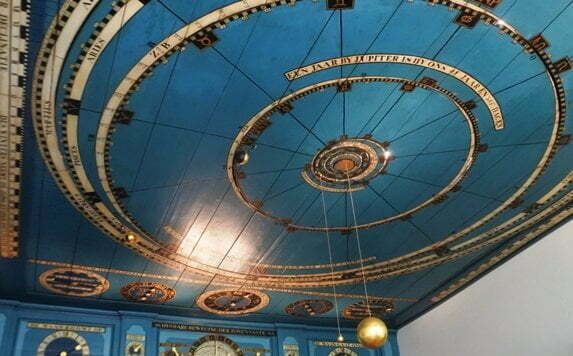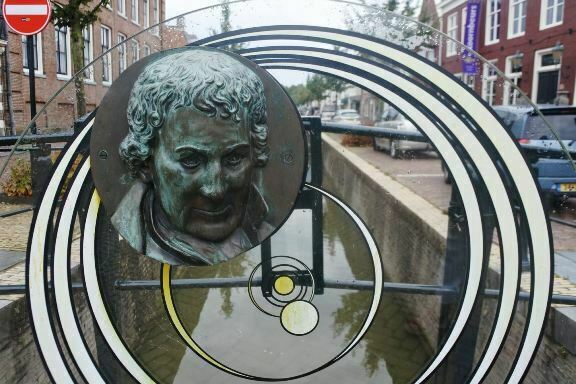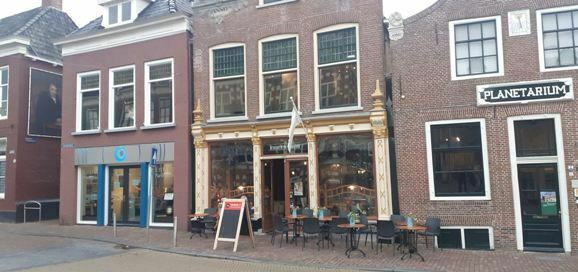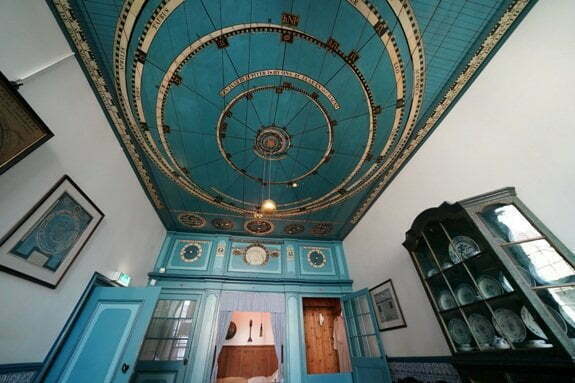
Down a roadside divided by a canal in the Dutch town of Franeker, you come across a smart museum frontage close to to a traditional Dutch brick building bearing the word ‘Planetarium’. Having purchased your ticket, you pass down narrow corridors built long before domestic spaces were designed to host public attractions. You enter an eighteenth-century living room. There is a round table with chairs in the centre. Around the walls there are tiles and pictures, a cabinet displaying crockery, a stove, a wardrobe, and an alcove with a bed, built for times when people sat upright to sleep. A drawer below hides a bed for small children. It is a living room where all the living might be done. Above, astonishingly, is the floor of heaven.
The ceiling of the living room is made of wooden boards painted in a cerulean blue. Within are concentric circles of white, gold and black paint, from which hang six planets, all that were then known to exist when this orrery (a clockwork model of the solar system), or Planetarium (as its inventor designated it), was completed in 1781. Hidden above the ceiling, an ingenious clockwork mechanism with wooden discs and several thousand wrought-iron pins sets the planets on their course to their correct timings. It would take just under twelve Earth years of standing in the living room, looking up at the recreated heavens, to see Jupiter make its complete circuit of the Sun. But fix one eye upon the Earth itself, with some object behind it as a reference point, and you will be able to seee the slightest of movement as it goes on its 365-day journey. There we are, and we move.

The Planetarium was the creation of Eise Eisinga (1744-1828), a Frisian wool-comber and amateur mathematician and astronomer. Eisinga had only limited schooling, but was intellectually gifted. Picking up on his wool-combing father’s interest in mathematics and astronomy, he became skilled in both, writing a book on the former when aged fifteen, and on the latter when aged eighteen. He was one of a network of amateur scientists in the Frisian area of the Netherlands that applied mechanical knowledge to intelligent enquiry, moving their world away from myth to the rational.
The story goes that Eisinga was inspired to build his Planetarium in response to local panic following a prediction made of cataclysmic chaos when the planets Mercury, Venus, Mars, Jupiter and the Earth’s moon would all be in conjunction, on 8 May 1774. Eisinga is said to have been driven to build his plan of the heavens as a means to instruct the superstitious public, though as it took him seven years to complete, the public would already have discovered that planetary conjunctions do not lead inevitably to apocalypse.

Eisinga’s vision and technical acuity were extraordinary. His solar system is a trillion times smaller than the actuality, but true to its scale of a millimetre to one million kilometres. It has the Sun at its centre, a giant orb hanging lower from the ceiling than the planets that circle round it. Circle is the correct word – one compromise he had to make was to make the paths of the planets circular rather than the ellipses that they trace in reality (the letters VP and NP for furthest and nearest point to the Sun are marked on each planetary path). The planets are proportionately at their correct distance apart from each other, but the Earth has been made far larger than it ought to be, simply so it could be visible.
There are other such alterations from scientific exactitude, but it is the realised idea of planetary motion that Eisinga wanted to get across, which is where he is so successful. Each planet is represented by a ball gilded on the side that faces the Sun. They pass round it at their true speed, mapped to their position in relation to the ecliptic plane (i.e. the Earth’s orbital plane, which is not the same as that of the other planets), and their relation to the signs of the Zodiac. The Moon rotates about the Earth, but all other moons are static, suspended from wires around their particular planets. A set of dials to the side of the main display give the year (the painted sign needs to be replaced with fresh years every twenty-two years), the days of the week, the phases of the Moon, sunrise and sunset, a celestial chart showing the apparent movements of the sun and stars from the Planetarium’s location, and so on. Everything is measurable and comprehensible. Nothing collides.
Theatrical presentations of the heavens, or planetariums, had a history going back to the Ancient Greeks, while several table-top clockwork models of the solar system had been made in the eighteenth century. Eisinga, however, was unaware of such precedents. Why did he build it on his ceiling? Perhaps it was the only space available to match his ambitions, or perhaps simply he wanted people to look up. He needed people to think above themselves.
Completed in 1781, the Planetarium has been in continuous operation ever since.

Eisinga’s Planetarium is an exceptional heritage site. It is the oldest working planetarium in the world. Its museum includes engrossing sections on historical and modern astronomy, as well as displays on the Eisinga wool-combing business. Three things struck me in particular about the place. The first was the remarkable network of so-called ‘farmer-professors’, lay astronomers and telescope manufacturers in the Dutch republic, particularly Friesland. They were inspired first by Dutch astronomer and educator Adriaan Metius (1571-1635) and then through the influence of the forward-thinking Franeker High School. It shows not only the values of the Enlightenment, but great contribution to knowledge that has so often been made to fields of enquiry by the so-called amateur. And the house that has scientific evidence literally built into it must be the epitome of amateur discovery.
Secondly was a slender link with the invention of film. Eisinga’s day-to-day business was wool-combing, at which he was successful. It was an industry that, at his time, was in the process of moving from hand craft to mechanised craft. A century later, the British inventor, political agitator and enthusiastic chess player, Wordsworth Donisthorpe also started out in his father George Edmund Donisthorpe’s wool-combing business, before seeking to develop motion picture photography as a means to illuminate society. He first applied for a patent for a proto-motion picture device in 1878, with a mechanism inspired by innovative ‘square motion’ wool-combing technology developed by his father (the camera was built but no designs survive, and we do not know if it worked at all). He revived his interest in 1888 with a fresh camera, taking a short (ten frames) film of Trafalgar Square in 1890, possibly with the idea of using film to promote his anarchistic political ideas. As Stephen Herbert writes of Donisthorpe and his co-inventor William Crofts:
It may be that the two inventors saw the machinery of the industrial revolution, specifically the wool-combing machines jointly devised by their fathers, as a legacy that could evolve into a mechanism of the communications revolution – the motion picture camera – ensuring their financial security, and perhaps even useful in promoting their extreme libertarian views.
Eisinga and Donisthorpe were at different poles when it came to wool-combing technology. The former’s business was still in the cottage industry era, productivity measured by human activity rather than machinery, though the toothed gear mechanism of the Planetarium strongly suggests the influence of its creator’s trade. The latter was the embodiment of the Industrial Revolution, showing how the application of one form of technology could inspire another. Both men, however, understood that technology might not simply drive processes but could open people’s eyes to the reality of things, be that solar or social reality.

Thirdly there is Pietje Jacobs, or Mrs Eisinga. Little is known about her. She married Eise at the age of twenty-four, bore three children (one dying young), and we know not much more than that. We are told that she assented to his ideas, so long as they would take no more than the seven years he had calculated. One might be sceptical of this, except that Eise was the kind of person who, if he said seven years, had calculated every process required down to the last day, if not hour. We know that she objected, not unreasonably, to her husband’s original intention of having a pendulum swinging over their alcove bed, and those plans were therefore altered. But what did she really think? It would be no great surprise if she was less than happy with the whole enterprise, given the nuisance of having the Planetarium built over such a long period, and then having to dwell, eat and sleep under this strange object.
Speculating further, there could have been more to her objections than mere inconvenience. Maybe Pietje did not welcome this rude introduction of reality over mystery into her house. Home should be the place of protection from the uncertain outside world, the place of domestic harmony. The Planetarium tore the roof open and exposed the heavens with all of their workings. There was no hiding now from a world of rationality, propelled and explained by technology. It was a world in which humans became very small indeed. The more they saw, perhaps the less they mattered.
But that is to assume that Pietje was one with those superstitious, God-fearing folk who dreaded the cataclysm predicted when the planets were conjoined. Married to a rationalist, instead she may have sympathised with, even encouraged the creation of a work that was not a stand-alone object but one that was a part of how and where they lived. There is a homespun quality to the Planetarium, an organic part of the household over which it looked, protectively. Perhaps Pietje saw her husband’s construction not as a threat, but as an expression of herself.

In the same year that the Planetarium was completed, 1781, William Herschel discovered a seventh planet, Uranus, but Eisinga would have needed a much larger living room to accommodate it. Not long after, he was forced to leave the country over a local political controversy. While he was in exile in Germany his wife Pietje died, in 1788. He remarried in 1792, by then living in the next-door province of Groningen, only returning to Franeker in 1795. He regained ownership of his house, started up the Planetarium once more and gained increasing recognition for his great achievement, culminating in a visit by King Willem I in 1818 and the purchase of the Planetarium by the State in 1825. When Eisinga died in 1828 he left his children detailed instructions on how to maintain the Planetarium, and it remained in the care of his descendants until 1922. It continued thereafter, becoming ‘Royal’ in 2006, expanding in 2008 to allow more space for exhibits and visitors. It is on a tentative list for designation as a UNESCO World Heritage site.
The Planetarium is a most marvellous place to visit, not simply for the solar system on the living room ceiling, but for the instructive museum and educational spaces that accompany it. People are allowed into the living room in small groups over a period of ten minutes or so, with a demonstrator pointing out the history and operation of the Planetarium (in different languages, depending on when you visit). Having all those people squeezed into such a small space detracts a little from the impact of the room itself, but not of the ceiling, which is majestic as it is homely, a thing of such beauty. You can then mount stairs to see the clockwork mechanism above and witness the heavens in operation, courtesy of enlightening technology and an unfettered imagination.
My thanks to Marja Kingma, a descendant of Eise Eisinga, for her help in putting this post together.
Links:
- The Eise Eisinga Planetarium website has useful information in Dutch and English
- A biography of Eisinga by Arjen Dijkstra was published (in Dutch) in 2021: De Hemelbouwer: Een biografie van Eise Eisinga
- Dr. William B. Ashworth, Jr. has written an entertaining and informative piece on Eisinga and the Planetarium for the Linda Hall Library site
- J. Mulder de Ridder, ‘Eise Eisinga and his planetarium‘, Journal of Astronomical History and Heritage, Vol. 5, No. 1 (2002) is a detailed study of the Planetarium’s operation (based on Eisinga’s own notes) with a useful account of the cultural background to his work, including the several amateur astronomers in Friesland at this period
- On the extraordinary Wordsworth Donisthorpe, see his entry on Who’s Who in Victorian Cinema and Stephen Herbert’s biography, Industry, Liberty, and a Vision
Wonderful account of an astronomical device i’d not heard of. Another reason to plan a visit to the he Netherlands, to see this as well as the Mesdag panorama.
Thank you Ian. Franeker is off the beaten tourist track but the Planetarium is well worth the pilgrimage. A post on the astonishing Mesdag Panorama is in preparation…
Good to know you’re writing about Mesdag. I recommend it to many, but have never visited!
Very cool
The Eisinga planetarium has been added to the UNESCO World Heritage sites list. https://www.dutchnews.nl/2023/09/extraordinary-franeker-planetarium-makes-unesco-heritage-list/